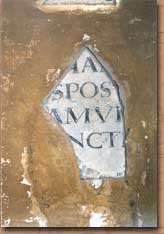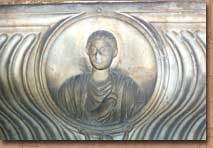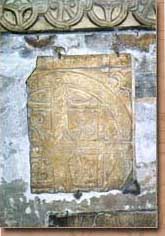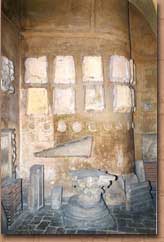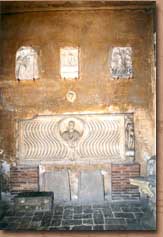The antiquarium:
The history and description of the collection
Formal charatteristics of the arrangement of the archaeological pieces
The history and description of the collection
edited by Raffaele Pugliese
During the restoration work Antonio Muñoz discovered a considerable quantity of stone material ( above all inscriptions, sculptural and architectonic fragments), which he arranged philologically in the cloister as if in a museum. Although his arrangement does not correspond to present-day museum and conservation practice, it is valuable as the testimony of a very precise phase in the life of the complex that should be studied and conserved in its entirety since it also forms part of the actual history of the building.
The arrangement takes into account the differences between the type of fragments and their chronology.On the basis of this choice the Christian funerary inscriptions, which had been removed from the ancient suburban cemeteries and used as building material during the early Middle Ages, were arranged along the east and part of the west wall. Instead the Roman material of mainly middle and late Imperial age, both epigraphic and decorative was placed along the remaining wall space, mainly on the west and north walls. On the latter, at its western end there are a series of tiles with inscribed stamps that were discovered during the work of renewing the roofs, evidence of the re-use of bricks over a wide time span. Finally, on the south side, some stone fragments originating from the decoration of the basilica during the Carolingian period were prominently positioned. However this arrangement also has its flaws as a result of the space available or the size and quantity of the materials.For example, some medieval pieces, such as the two marble slabs with cosmatesque mosaic decoration or a splendid fourteenth century tombstone were positioned on the west and north walls respectively.
The material displayed for quality and documentary value is of particular interest even though it often does not relate to its context. Among the stone inscriptions there is a fragment of historical importance bearing a poem by Damasus in the splendid script known as Philocalian. It was written by Pope Damasus (366-384), profound worshipper of the Roman martyrs, in honor of Saints Marcellinus and Peter and engraved by the stonemason Philocalus in an extremely elegant and classical style (fig. 1). The fragment was at one time in the catacomb dedicated to the two saints on the Via Labicana and must have arrived at the Coelian basilica in the early Middle Ages, perhaps following the removal of the bodies of the four crowned martyrs by Pope Leo IV (847-855) from the same cemetery.
The collection from the Roman age is more variegated but still significant; among the pieces are two marble friezes of mid-Imperial age with elaborate and luxuriant vegetation which conceals putti and animals and some sarcophagus fragments with pastoral or philosophical themes dating between the second half of the 3rd. and the 4th. century.On the west side, the front of the sarcophagus with the image of a young man is of interest not only for its fine workmanship but also because of the fact that the face has been re-worked over a preceding one of a scarcely outlined adult, evidence that these works were produced in series and then adapted according to each individual case (fig. 2).
Also of importance are a number of plutei (fig.3) and numerous marble enclosure pilasters in which typical decorative motifs of early medieval Roman sculpture are combined to form an elaborate ornamental design: ribbons, rosettes, birds, flowers and vegetation.They bear witness to the richness and high quality of the work carried out during the Carolingian age to embellish the presbyterial area.
Formal characteristics of the arrangement of the archeological pieces
edited by Monica Morbidelli
The arrangement of the archaeological pieces on the walls of the cloister by Muñoz was also inspired by aesthetic criteria. There are calculated compositional sequences in which the pieces have been positioned according to principles of symmetry and spatial equilibrium. The aesthetic value of the composition is the probable result of a thoughtful study and of choices of taste that have been identified through carefully evaluating and analysing his organizing principles. The criterion is obviously not always the same, but changes depending on the size and type of the pieces as well as on the nature of the surface to which they are attached.Where the surfaces are completely free, pieces of similar dimensions have in some cases been arranged in parallel lines (fig.4); in other cases separate zones have been created in which a group of pieces becomes a feature in itself with its own internal equilibrium (fig. 5).Even the arrangement in parallel lines is often alternated between lines of small pieces and lines of larger pieces.
Where the surfaces are vertically interrupted (by columns, doors...) the balance of the composition has been preserved within the outline of the corridor wall by a plan that is almost identically repeated and where the lower part is occupied by a large piece of sculpture in a horizontal position (sarcophagi, plutei...) and the upper part has three smaller symmetrically-positioned pieces.
Often a greater space is left between the two levels by positioning single pieces in the center for contrapuntal effect (fig.5). Where the surfaces are confined to a small area, very small and fragmented pieces have been grouped together or decorative architectural stone designs have been reconstructed by piecing disconnected elements together.
|
© 1999 Coordination
Monica Morbidelli |
|
Fig. 1 - Fragment of the poem written by Pope Damasus (366-384) in honor of Saints Marcellinus and Peter and affixed to their tomb. The creator and engraver of this very particular script was Furius Philocalus, a close friend of the Pope.
Fig. 2 - Front of fluted sarcophagus with finely modelled portrait of the deceased young man, his look now far away from the sufferings of life (3rd century A.D.).
Fig. 3 - Altar frontal in marble with an elaborate design of aniconic interlacery, carried out by the craftsmen of Pope Leo IV (847-855).
Fig. 4 - North wall: example of arrangement of parallel lines; collection of stamped Roman tiles and brick stamps; below, a fragment of rubricated inscription.
Fig. 5 - West wall: example of a group of symmetrically-positioned pieces that adorn a wall or occupy a confined panel; front of fluted Roman sarcophagus and three fragments of funerary reliefs with Roman head.
|
|
|
|
|
|
|
|
|
|
|
